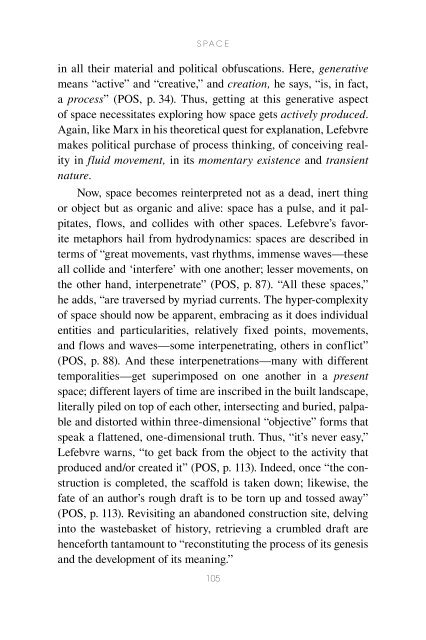Henri Lefebvre: A Critical Introduction - autonomous learning
Henri Lefebvre: A Critical Introduction - autonomous learning
Henri Lefebvre: A Critical Introduction - autonomous learning
Create successful ePaper yourself
Turn your PDF publications into a flip-book with our unique Google optimized e-Paper software.
s p a c e<br />
in all their material and political obfuscations. Here, generative<br />
means “active” and “creative,” and creation, he says, “is, in fact,<br />
a process” (POS, p. 34). Thus, getting at this generative aspect<br />
of space necessitates exploring how space gets actively produced.<br />
Again, like Marx in his theoretical quest for explanation, <strong>Lefebvre</strong><br />
makes political purchase of process thinking, of conceiving reality<br />
in fluid movement, in its momentary existence and transient<br />
nature.<br />
Now, space becomes reinterpreted not as a dead, inert thing<br />
or object but as organic and alive: space has a pulse, and it palpitates,<br />
flows, and collides with other spaces. <strong>Lefebvre</strong>’s favorite<br />
metaphors hail from hydrodynamics: spaces are described in<br />
terms of “great movements, vast rhythms, immense waves—these<br />
all collide and ‘interfere’ with one another; lesser movements, on<br />
the other hand, interpenetrate” (POS, p. 87). “All these spaces,”<br />
he adds, “are traversed by myriad currents. The hyper-complexity<br />
of space should now be apparent, embracing as it does individual<br />
entities and particularities, relatively fixed points, movements,<br />
and flows and waves—some interpenetrating, others in conflict”<br />
(POS, p. 88). And these interpenetrations—many with different<br />
temporalities—get superimposed on one another in a present<br />
space; different layers of time are inscribed in the built landscape,<br />
literally piled on top of each other, intersecting and buried, palpable<br />
and distorted within three-dimensional “objective” forms that<br />
speak a flattened, one-dimensional truth. Thus, “it’s never easy,”<br />
<strong>Lefebvre</strong> warns, “to get back from the object to the activity that<br />
produced and/or created it” (POS, p. 113). Indeed, once “the construction<br />
is completed, the scaffold is taken down; likewise, the<br />
fate of an author’s rough draft is to be torn up and tossed away”<br />
(POS, p. 113). Revisiting an abandoned construction site, delving<br />
into the wastebasket of history, retrieving a crumbled draft are<br />
henceforth tantamount to “reconstituting the process of its genesis<br />
and the development of its meaning.”<br />
105
















